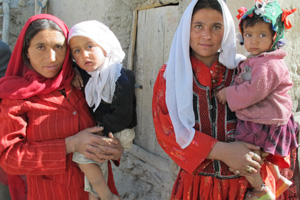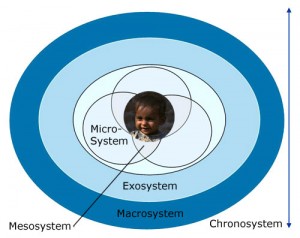1. Contexts of early human development

What makes us who we are? Every human being is unique. Though we may share many qualities with others, there are no two beings who are exactly the same. Even identical twins differ as they grow up.
Children come into the world with unique genetic predispositions that listen and respond to the world around them. From conception on, a child’s world is shaped by other individuals, available resources, opportunities, and cultural patterns. Because each child is different, children who experience similar environments can have very different outcomes. In turn, children themselves affect their environments.
Think about your own childhood. How would you describe the people, places, and events that remain significant memories for you?
How do you think these may have influenced your development?
What has a strong influence on your life now?
Children grow up surrounded by people, places, and events that shape their daily lives and future prospects. They survive and thrive in widely varying geographical, cultural, sociopolitical, and economic conditions. The following images show some of the very different surroundings in which children live.
Even within the same country, children may have very different experiences. Consider the example below of two children living in rural and urban settings in coastal Kenya.
Consider… Daily village life in Kakayuni…Big City
In Kakayuni village, Kenya, five-year-old twins, Naima and Abdullah, supported only by their very overstretched grandmother, live in a mud shack with an earth floor… Salim lives in a big city
In Mombasa, six-year-old Salim lives in rented accommodations with his parents and three siblings just off Mwembe Kuku street, a very busy hawking and vending area… Read more
Listen to the late Dr. Fraser Mustard, co-founder of the Council for Early Childhood Development, explain the importance of environments in the survival of the human species – now and in the past.
In the next reading, Mothers and others needed for healthy human development, from the Early Years Study 3 (McCain et al., 2011, pp. 5 – 8), Mustard discusses his own career trajectory and how he has been influenced by the work of Sarah Blaffer Hrdy’s. The reading discusses some of the main ideas of her work.
What does the well-used phrase “it takes a village to raise a child” mean to you?
How are family structures influenced by social and economic institutions?
What kinds of communities does Fraser Mustard suggest support optimal early human development?
Each individual child lives within his or her immediate social, physical, and cultural environment. At the same time, the systems in the child’s environment interact with each other. A child’s world typically includes family members, friends, neighbourhood, possibly early childhood programs, school, and often places of faith. Less immediate but powerful forces affecting children’s worlds include laws, governments, formal institutions, values, and the physical environment.
Bioecological Systems Theory
Urie Bronfenbrenner’s Ecological Systems Theory (1979) has greatly influenced the study of child development. His theory, commonly depicted as nested circles, describes the relationships and interactions between a child’s immediate context (family, friends, and early childhood programs) to larger environmental systems (national economy, political structures, laws, values, and culture). Bronfenbrenner later recognized the influence of a child’s own biological system and incorporated that into this theory, renaming it the Bioecological Systems Theory.
How is Bronfenbrenner’s theory applicable to research about early child development in the majority world?
How do you think Bronfenbrenner’s own early experience shaped his perspective on human development?
What do you see as the important elements in the child’s microsystem? Think of a specific child you know.
Consider how a change in any aspect of this model would affect you. For example, what if you were a different gender or grew up in a much larger or much smaller family? How might this change have made a difference in your life?
Click on the next review game to check your understanding of Bronfenbrenner’s theory.
The point of the ecological model…is to break away from a myopic focus on the structure and dynamics of the family of origin. Endless studies have dissected the influence on children of variations on family structure….While family systems are important factors in the ecology of childhood, this narrow focus can obscure the influence of the other systems highlighted by the ecological model” (Woodhouse, 2020, p. 29).
Dr. Mildred Warner, professor of City and Regional Planning at Cornell University, wants us to consider person, place, and context when we think about how children develop. She cautions against the notion that we can insert a dollop of early learning for a year or so without considering the child, family, neighbourhood, and broader community.
Nurturing Care for Early Childhood Development Framework (NCF)
The Nurturing Care Framework (NCF), launched in May 2018 by WHO, UNICEF, and other partners, is currently one of the most globally influential initiatives for early childhood, influencing policymakers and programs around the world. While the bioecological systems theory provides a holistic way of thinking about child development, the NCF provides a comprehensive and visionary collection of principles, policies, and strategies to help children, especially those who are vulnerable, to survive and thrive. The NCF takes an ecological approach that considers all aspects of life from home and community life to large, public policies – referred to as a “whole of government, whole of society approach” (NCF, 2018).
You were briefly introduced to the NCF and the specific components of nurturing care as outlined in the Framework, in the Brain Development module. The following executive summary (also available in Arabic, Spanish and French) provides a broad overview of the NCF.
Test your recall of the above reading with the following interact.
All levels within the bioecological framework are encompassed within the NCF. Keeping this in mind, to what extent do you see all five aspects of Nurturing Care, provided to most children where you live?
Do your local authorities and does your national government show evidence of understanding and acting upon some of the recommendations in the NCF? How?
How closely are public and private sectors working together to provide nurturing care in your context? Can you think of any actions you and your colleagues could take to further nurturing care?
There is a wealth of information, frequently updated and including resources in several languages on the Nurturing Care for Early Child Development website.
You will learn more about the Nurturing Care Framework on pages 2.4, 2.5 and 3.3 of this module as well as in the Developmental Health module.



